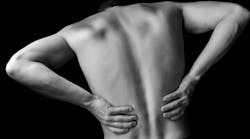Lower-back pain is the No. 1 cause of job-related disability in the United States, and one of the leading causes of lost workdays. Only headaches and colds are more common than back pain.
According to Tadhg O’Gara, M.D., an orthopedic surgeon at Wake Forest Baptist Medical Center in Winston-Salem, N.C., the best way to prevent lower-back pain is to remember this simple mantra: “Arch is good, flat is bad.”
“The key to avoiding lower-back pain is keeping pressure off your lower lumbar discs,” O’Gara says. “That means keeping an arch to your lower back.”
Sustained physical activity (playing sports or doing yardwork) or a sudden jolt (a vehicle crash) can cause acute lower-back pain. While the pain can be intense, it generally doesn't last long. On the other hand, chronic lower-back pain – the kind that lasts for more than three months – is more debilitating and more difficult to treat.
Much of that chronic pain is caused by damage to the discs – the spongy, multi-function structures that lie between the spine’s vertebrae – in the lower part of the back right above the pelvis (an area known as the lumbar region). And much of that damage is caused by poor body mechanics – the way people stand, walk, lift, carry, reach, bend, sit and sleep – in which the back is flat, not arched.
The intervertebral discs – essentially the spine’s shock absorbers – are under constant pressure, especially in the lower back, which supports the weight of the upper body. The five vertebrae in the lumbar region are naturally arched toward the front of the body, so bending forward compresses the front of these disks, which over time can force them out of position to press on one or more of the nerves emanating from the spinal cord.
This condition – known as a bulging, herniated or ruptured disc – can cause pain in the lower back and elsewhere, especially the buttocks, thighs and even below the knee (sciatica). And that pain can be severe.
“People who haven’t had lower -back pain don’t realize how painful it is,” O’Gara says. “And many health care providers don’t realize how painful it is.”
Treatment of Lower-Back Pain
So how is chronic lower-back pain treated?
“The first thing to figure out is what exactly is causing the pain, because that determines what approach to take with treatment,” says Kristopher Karvelas, M.D., assistant professor of physical medicine and rehabilitation at Wake Forest Baptist. “That’s not always easy. Pain is usually related to the discs, but other causes of low-back pain have overlapping symptoms and pain patterns.”
Basic diagnostic methods include physical examination, review of the patient’s medical history and patient descriptions of the onset, location, severity and duration of the pain and of any limitations in movement. Imaging techniques such as X-rays, MRI and CT scans also can be employed to pinpoint the source of pain.
Once the reason behind the pain is determined, the most frequently prescribed treatment is physical therapy, not surgery.
“I typically reserve surgery for patients who have a medical need other than pain,” Karvelas says. “There’s a large toolbox that we can go to for patients, and surgery is the last tool.”
Depending on the individual patient’s condition, physical therapy programs usually include exercises designed to strengthen back and abdominal muscles and to promote proper posture and balance. These can include stretching, swimming, walking and even yoga. But education also is a key element.
“Patients need to recognize that posture and activity are crucial in relieving and preventing back pain,” Karvelas says. “They need to learn what exercises to do on their own and how to do them properly to prevent future flare-ups.
“We can help resolve acute back-pain episodes, but when we are talking about chronic back pain, the pain may never resolve completely. However, we do use a team approach to treat patients and teach people how to cope with their pain effectively.”
